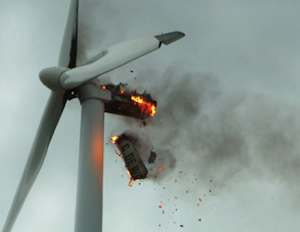General News
3 wind-turbine failures firefighters must know
By Chief Gary Bowker (Ret) | FireRescue1 | www.firerescue1.com 25 June 2012
By Chief Gary Bowker (Ret) | FireRescue1 | www.firerescue1.com 25 June 2012
Wind-farms have been around for several decades in Europe, but only in recent years have we seen them appear in the United States. The United Kingdom has experienced a dramatic increase in wind-turbine incidents resulting in a number of civilian injuries and deaths in the past decade, according to a report by Caithness Windfarm Information Forum 2012.
As more communities are using wind energy, many fire departments likewise across the United States are seeing wind-farms being built within their response areas. And as with most new advances in technology new challenges also arise for the fire service.
According to the trade group, American Wind Energy Association, there are utility-scale wind turbines in 38 states, 14 of those states generate at least 1,000 megawatts of power. And growth in this industry seems likely.
AWEA reports that U.S. wind turbines generate 48,600 megawatts; the on-shore potential is estimated at 10.4 million megawatts. To narrow that gap, there are nearly 100 projects in 31 states and Puerto Rico to add wind-generated capacity.
To increase their situational awareness regarding this growing trend, firefighters need to understand the top three types of wind-turbine failures. It is equally important to know the life-safety guidelines to consider when facing this new challenge.

Blade Failure
Blade failure is by far the most common type of failure and is responsible for most of the incidents reported by the CWIF. Blade failure can occur when the blades are damaged such as the result of bird strikes, storm damage, or a runaway/over-speed turbine motor with brake failure.
Fire
The second most common incident is the result of fire. Fires can occur from a number of sources, however, mechanical gearbox failure has plagued the industry for years. Other fire causes include electrical malfunctions and lightning strikes.
Structural failure of tower
While considered to be the least common type of failure, tower failure can occur from damage during transport, high winds, blade strike or lack of maintenance. A fire originating in the motor housing can spread to the composite fiber blades, and into the structural tower resulting in collapse. Blade strike is believed to be the cause of a tower collapse that occurred recently near Weatherford, Okla.
Firefighter life safety considerations
The obvious challenge facing firefighters is the height involved if a fire occurs in the turbine motor. Towers can extend 300 to 400 feet above ground.
However, due to the risk of falling fire debris over a wide area, approaching a burning turbine is usually not an option unless there is a life risk involved. If the turbine is turning, power is being generated and an electrocution hazard will be present.
Typically, a good option for firefighters to consider is to evacuate any endangered areas, set up a collapse zone, and attempt to control any ground fires to prevent the fire from spreading to other units.
In the case of a runaway or over-speed event, rotating turbines can throw debris thousands of feet away during a blade failure. Pieces of blades have been documented as traveling over 4,200 feet. Distance and time will fix this problem. Pre-incident planning and SOP development are keys to success for safely handling this unique danger.
—
About the author
Gary Bowker is a retired fire chief with the U.S. Air Force, and has served as fire chief with the Sumner County, Kansas Rural Fire District #10. Chief Bowker retired as fire marshal with the City of Winfield, Kansas and has over 38 years of fire service experience. He has taught numerous courses with the National Fire Academy, U.S. Department of Defense, and is an Associate Instructor with the University of Kansas Fire & Rescue Training Institute. He serves as a Kansas advocate with the National Fallen Firefighters Foundation’s Everyone Goes Home® program and speaks frequently and has written numerous articles on firefighter life safety and health issues. He is nationally certified as a Fire Officer II, Instructor II, Inspector II, Certified Fire & Explosion Investigator (CFEI), and he holds a B.Sc. degree in Fire Science Administration. Chief Bowker can be reached at: glbowker@hotmail.com
URL to article: https://www.wind-watch.org/news/2012/06/26/3-wind-turbine-failures-firefighters-must-know/